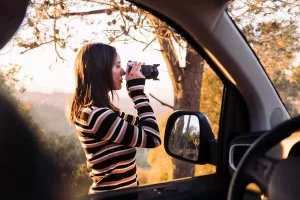Promoting eco tourism travel through photographic art offers a unique opportunity to bridge the gap between stunning visuals and environmental conservation. By capturing the essence of natural landscapes and local cultures, photographers can evoke emotional responses that inspire responsible travel behaviors. The integration of compelling imagery into marketing strategies not only enhances awareness but also fosters community engagement. As the landscape of what is eco tourism travel evolves, exploring innovative visual storytelling techniques could deepen the connection between travelers and nature.
Key Takeaways
- Utilize stunning visuals of natural landscapes and wildlife to evoke a sense of wanderlust and inspire conservation efforts among potential travelers.
- Engage social media platforms with captivating photography to foster community interaction and promote eco-conscious travel narratives.
- Collaborate with local artists to enhance authenticity and showcase cultural heritage through unique photographic perspectives.
- Create immersive experiences that connect travelers emotionally to the environment, encouraging them to appreciate and protect it.
- Develop compelling storytelling around photographs to highlight the significance of biodiversity and sustainable practices in eco tourism.
Understanding Eco Tourism Travel and Its Importance
Although many travelers seek adventure and relaxation in exotic locations, understanding eco tourism travel and its importance is essential for fostering a sustainable future. Eco tourism travel is defined as responsible travel to natural areas that conserves the environment and improves the well-being of local communities. It not only promotes awareness of the delicate balance between nature and society but also encourages travelers to respect cultural heritage and biodiversity. By choosing eco-friendly options, travelers can contribute to conservation efforts, support local economies, and participate in authentic cultural experiences. This mindful approach fosters a sense of belonging within global communities, creating a shared responsibility for preserving our planet’s beauty. Fundamentally, eco tourism travel nurtures both the traveler and the environment, paving the way for sustainable exploration.
The Role of Photographic Art in Eco Tourism Promotion
Photographic art serves as a powerful medium for promoting eco tourism travel by capturing the stunning beauty of natural landscapes and the rich cultural heritage of local communities. Through evocative images, photographers can ignite a sense of wanderlust and connection, inspiring individuals to engage with nature responsibly. These visuals not only highlight the uniqueness of each destination but also emphasize the importance of conservation and sustainable practices. By showcasing the delicate balance between human activity and environmental preservation, photographic art cultivates a collective identity among eco-conscious travelers. As audiences resonate with these compelling narratives, they are encouraged to explore eco tourism travel options that honor and protect the natural world, fostering a deeper sense of belonging to the global community of nature enthusiasts.
Strategies for Integrating Photography Into Eco Tourism Marketing
How can the integration of photography elevate eco tourism marketing efforts? By harnessing the power of visual storytelling, eco tourism businesses can create compelling narratives that resonate with potential travelers. Effective strategies include:
- Highlighting local biodiversity: Showcase the unique flora and fauna of eco tourism destinations to inspire a sense of wonder and conservation.
- Creating immersive experiences: Use photographs to convey the emotional and sensory experiences of eco-friendly travel, fostering a connection with nature.
- Engaging social media campaigns: Leverage platforms to share stunning images that encourage community participation and interaction, amplifying the reach of eco tourism messages.
- Collaborating with local artists: Partner with photographers who understand the essence of eco tourism, enhancing authenticity and attracting a like-minded audience.
These strategies can greatly enhance the visibility and appeal of eco tourism travel.
Case Studies: Successful Eco Tourism Campaigns Through Photography
The power of photography in eco tourism marketing is exemplified through various successful campaigns that have effectively captured the essence of sustainable travel. One notable case is the “Take Only Pictures, Leave Only Footprints” campaign, which encouraged travelers to document their experiences while committing to environmental preservation. Stunning visuals showcased breathtaking landscapes and endangered species, igniting a sense of responsibility among viewers. Similarly, the “Nature’s Palette” initiative utilized vibrant imagery to highlight local cultures and biodiversity, fostering a connection between travelers and their destinations. These campaigns not only inspired wanderlust but also cultivated a community of eco-conscious travelers. By illustrating the profound beauty of nature, they reinforced the importance of eco tourism travel, inviting individuals to explore while preserving the planet.
Future Trends in Eco Tourism and the Influence of Visual Art
As eco tourism continues to evolve, emerging trends indicate a growing reliance on visual art to enhance traveler engagement and promote sustainable practices. This synergy not only enriches the travel experience but also fosters a deeper connection to the environment. Key future trends include:
- Interactive Installations: Art that encourages participation, allowing travelers to contribute to eco-friendly initiatives.
- Digital Storytelling: Utilizing social media to share compelling narratives that inspire responsible travel.
- Local Art Collaborations: Partnering with local artists to promote cultural heritage and conservation efforts.
- Augmented Reality Experiences: Immersive technologies that blend art with ecological education, making learning about sustainability more engaging.
These trends highlight how visual art can transform eco tourism travel into a more impactful and meaningful journey for all.
Frequently Asked Questions
How Can Travelers Ensure Their Eco Tourism Practices Are Sustainable?
Travelers can guarantee their eco tourism practices are sustainable by supporting local businesses, minimizing waste, respecting wildlife, engaging in conservation efforts, and choosing eco-friendly accommodations, fostering a deeper connection with nature and local cultures.
What Are the Benefits of Eco Tourism for Local Communities?
Eco tourism travel benefits local communities by fostering economic growth, preserving cultural heritage, and promoting environmental conservation. It encourages sustainable practices, enhances community pride, and creates job opportunities, ultimately enriching both the local economy and visitor experience.
How Does Photographic Art Influence Traveler Decision-Making?
Photographic art profoundly influences traveler decision-making by evoking emotions and showcasing destinations’ beauty. Engaging images inspire wanderlust, fostering a sense of connection to nature, and motivating individuals to choose eco tourism travel for sustainable experiences.
Are There Certifications for Eco Tourism Destinations?
Yes, there are various certifications for eco tourism destinations, such as Rainforest Alliance and Green Globe. These certifications assure travelers of sustainable practices, fostering a sense of belonging to a community that values environmental responsibility.
What Equipment Is Best for Capturing Eco Tourism Photography?
A versatile DSLR or mirrorless camera, paired with a wide-angle lens, tripod, and polarizing filter, proves ideal for capturing eco tourism photography, enabling stunning landscapes and detailed wildlife shots that resonate with viewers’ environmental consciousness.
Conclusion
To summarize, promoting eco tourism through photographic art serves as a powerful catalyst for conservation and cultural appreciation. By harnessing stunning visuals that resonate emotionally with audiences, stakeholders can inspire a deeper connection to nature and local heritage. As strategies evolve and case studies showcase successful campaigns, the future of eco tourism will increasingly rely on the creative integration of photography. This approach not only fosters eco-conscious communities but also champions responsible travel practices that safeguard our planet for generations to come.
May You Also Like to Read:


